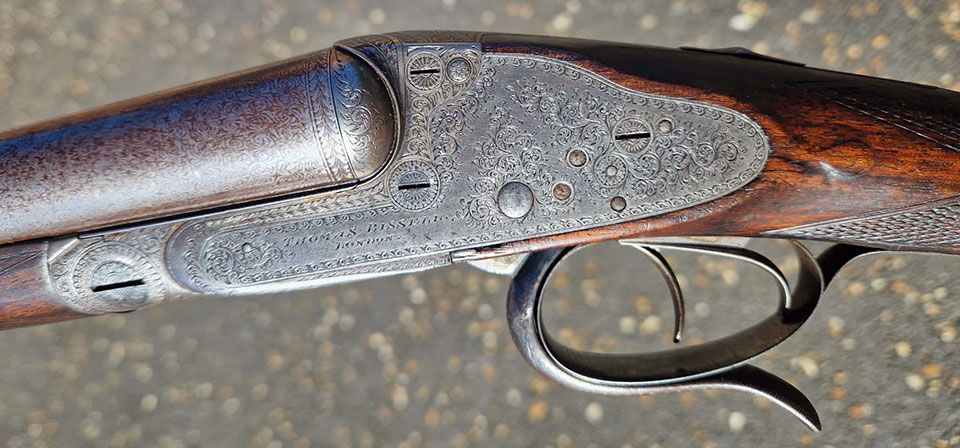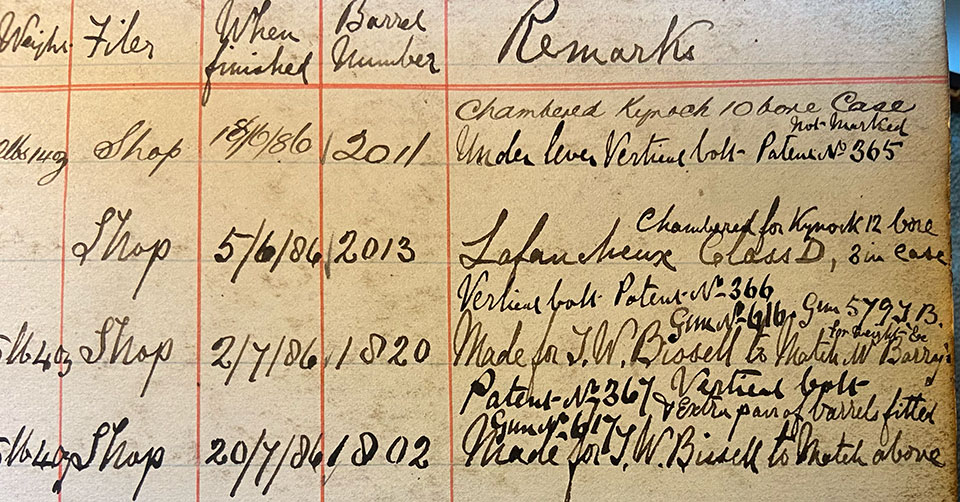Thomas Bissell invented one of the classic sporting breech-loaders in 1879 but, like many of the men whose minds created the mechanisms sportsmen came to know and love, Bissell is less well remembered than his wealthier co-patentee.

The action he designed was a treble-grip, making use of the 1863 Purdey bolt, which had run out of patent protection, and a hollowed-out rib extention which accommodates a locking bolt that rises from a recess in the action body. The bolt is retracted by a top-lever (or under-lever in this case) and snaps back into place when the gun is closed.

Bissell's collaborator was John Rigby and the action gained wide recognition as the 'Rigby Rising Bite', though it is referred to in the patent description as a 'vertical bolt'. The gun you see here is one of Bissell's own make, carrying his name and the address: 75, Cranham Road, South Bermondsey, London'. He traded there from 1877-1886, so probably conceived of this action in those premises.
The gun pictured here is very like a classic Rigby of the period, with Rigby fences and dipped-edge lockplates.
Rigby's records show that Thomas Bissell made actions for them and the two shared royalty income (which was £1.10.s 0d each for every gun made)

This gun has Bissell serial No.590 stamped on the action and patent use No.177, along with the 'TB' intertwined motif that was his trademark.
Rigby’s relationship with Thomas Bissell was longstanding and journals from the period contain numerous references to ‘Mr Bissell’. He lived at 98 Hollydale Road, Peckham. This is still standing today; a modest end of terrace Victorian house of two stories, with a small garden, some six miles from Rigby’s then shop.
He is recorded as operating his business just across the Thames from the Tower of London, at 76, Tooley Street in 1857, moving to 75, Tooley Street in 1858 and moving again to 73, Tooley Street in 1870 and staying there until 1875.
Bissell's name appears in Rigby's production journals as early as 1872, by which time he was prolific, being listed as 'Actioner', 'Stocker & Screwer' and 'Finisher'. This suggests he probably employed other gunmakers in his business, as the amount of work he was listed against at Rigby's would be too much for one man to do alone.
Bissell was at 75-77, Cranham Road, Rotherhithe New Road from 1877-1886; the period in which the co-patent with Rigby was being worked-out. Records then revert to his home address; 98 Hollydale Road, Peckham from 1889-1891. After that, he disappears.

His most famous patent is No.1141 of 1879, which this gun conforms to. It is a 12-bore snap-under-lever. Like Rigby's of the period, the forend is attached by a grip catch with forward facing lever of the type atented in 1866 by Charles Harvey.
The first 'vertical bolt' gun mentioned in Rigby's records is Gun No.15027, made for 'London' on August 15th 1879. The patent was not sealed until 20th September that year.

This gun probably dates from 1880 and is one of the earliest hammerless vertical bolt guns, though others by Bissell are known to exist.

The earliest hammerless Rigby version we have seen to date carries use No.108 and that was sold in July 1880.

It is nice to see representations of patents like this on guns which carry the name of the inventor. Thomas Bissel deserves to be remembered. His work has continued to be relevant and in 2024 Rigby offer this action in shotgun and rifle guises as their best work.
Although it is now almost universally known as the 'Rising Bite', in fact, no mention of the term 'rising bite' is to be found in the records at all. Rigby's ledgers, when the action is mentioned, refer to a 'vertical bolt', a 'Bissell Action' or an 'R&B action' (Rigby & Bissell). The 1886 action books refers to 'vertical bolt' repeatedly. It also shows that Rigby was making some of these guns for Thomas Bissell, or at least selling him barrelled actions of his own design.
One such entry reads: 'Action No.2014, bar action shotgun, hammerless, finished on 2/7/86, with barrel number 1802, Made for T.W. Bissell, to match W. Barry's gun. Vertical Bolt. Gun No.616. Patent No.367'
So, it seems likely the gun photographed here was probably at least partley made for Bissell in Rigby's workshops. The two gunmakers certainly enjoyed a long and mutually beneficial collaboration which spanned a period of at least twenty years.

Published by Vintage Guns Ltd on (modified )




